You can feel good about having a native flower haul to harvest because you’re helping support a diversity of pollinators in your own backyard. And since native plants are resilient, you’ll likely spend way less time watering and worrying about your native cut flower garden. When growing a cut flower garden your best results will come by following a few of nature’s unwritten rules: stick with plants that are suited for your USDA hardiness zone; ensure your plants are appropriate for your existing light, soil, and moisture conditions; and choose cutting garden plants that have overlapping blooming periods so you’ll have multiple flowers blooming concurrently for the most fantastic home bouquets. Below we’ve prepared five cut flower garden recipes suiting several themes and growing conditions – even one that doesn’t need a garden bed at all! You’ll appreciate the colors, textures, and fragrances they bring to your bouquets, and the support they offer your local fauna.
1. A Water-Wise Container Garden
Container gardens require a constant eye on moisture. That’s when drought-tolerant plants come to the rescue. Plant each of these sun-loving native plants in one large rectangular raised bed, or place them individually in pots of varying sizes and arrange them on your porch or patio to your liking.
2. A Pocket of Prairie
With so little original American prairieland left, incorporating perennials from this region into a garden offers a lifeline to wildlife that depend on prairie plants. Lucky for you, plenty of sunny prairie perennials produce gorgeous flowers and textures for vases and arrangements.
3. Scent-sational Aromas
Proving that natives can be functional and fabulous, these scent-filled plants fill both garden and home with alluring fragrances.
4. Fantastic For Fall
Gathering the last the garden has to offer seems a duty, and arranging it into a beautiful bouquet can become a lesson in breaking all the rules. Anything goes – flowers, foliage, seed pods, even “weeds”!
5. Pollinator Magnets
In the end, our enjoyment of a native cut flower garden is a byproduct of what the garden is really all about, and that is providing food and shelter for pollinators. The Plant By Number native cut flower garden planting kit, available on the Gardening Know How Shop, will get you on your way to sustaining a pollinator population quickly and easily with a 5ft x 8ft planting plan, fabric planting map, and plants that will attract bees, butterflies, and hummingbirds. The design is printed directly on the planting template for “get it right the first time” installation. All varieties here prefer loads of sun and rich, loamy soils. A second Native Cutting Flower planting kit, available on the Gardening Know How Shop, doubles up on the pollinator-friendly plantings with an array of blues and purples with blue false indigo and New England asters, both white and purple coneflowers, and the greens and purples of a Green Twister coneflower that will add a bit of drama to any bouquet. This article features products available from third-party vendors on the Gardening Know How Shop.
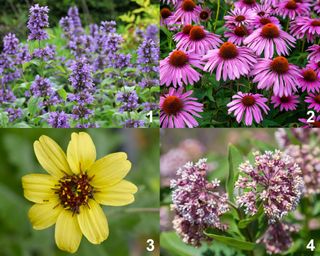
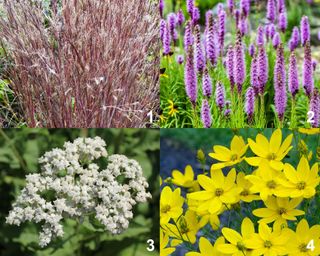
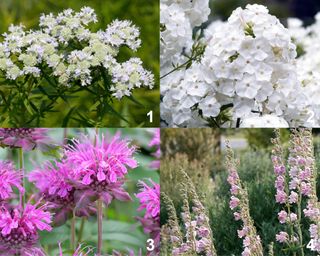
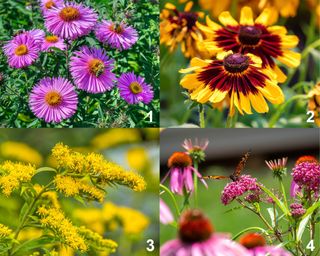
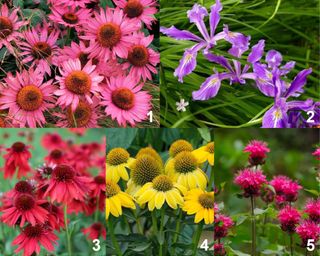
title: “Grow A Native Cut Flower Garden 5 Planting Recipes” ShowToc: true date: “2024-10-16” author: “Kathryn Green”
You can feel good about having a native flower haul to harvest because you’re helping support a diversity of pollinators in your own backyard. And since native plants are resilient, you’ll likely spend way less time watering and worrying about your native cut flower garden. When growing a cut flower garden your best results will come by following a few of nature’s unwritten rules: stick with plants that are suited for your USDA hardiness zone; ensure your plants are appropriate for your existing light, soil, and moisture conditions; and choose cutting garden plants that have overlapping blooming periods so you’ll have multiple flowers blooming concurrently for the most fantastic home bouquets. Below we’ve prepared five cut flower garden recipes suiting several themes and growing conditions – even one that doesn’t need a garden bed at all! You’ll appreciate the colors, textures, and fragrances they bring to your bouquets, and the support they offer your local fauna.
1. A Water-Wise Container Garden
Container gardens require a constant eye on moisture. That’s when drought-tolerant plants come to the rescue. Plant each of these sun-loving native plants in one large rectangular raised bed, or place them individually in pots of varying sizes and arrange them on your porch or patio to your liking.
2. A Pocket of Prairie
With so little original American prairieland left, incorporating perennials from this region into a garden offers a lifeline to wildlife that depend on prairie plants. Lucky for you, plenty of sunny prairie perennials produce gorgeous flowers and textures for vases and arrangements.
3. Scent-sational Aromas
Proving that natives can be functional and fabulous, these scent-filled plants fill both garden and home with alluring fragrances.
4. Fantastic For Fall
Gathering the last the garden has to offer seems a duty, and arranging it into a beautiful bouquet can become a lesson in breaking all the rules. Anything goes – flowers, foliage, seed pods, even “weeds”!
5. Pollinator Magnets
In the end, our enjoyment of a native cut flower garden is a byproduct of what the garden is really all about, and that is providing food and shelter for pollinators. The Plant By Number native cut flower garden planting kit, available on the Gardening Know How Shop, will get you on your way to sustaining a pollinator population quickly and easily with a 5ft x 8ft planting plan, fabric planting map, and plants that will attract bees, butterflies, and hummingbirds. The design is printed directly on the planting template for “get it right the first time” installation. All varieties here prefer loads of sun and rich, loamy soils. A second Native Cutting Flower planting kit, available on the Gardening Know How Shop, doubles up on the pollinator-friendly plantings with an array of blues and purples with blue false indigo and New England asters, both white and purple coneflowers, and the greens and purples of a Green Twister coneflower that will add a bit of drama to any bouquet. This article features products available from third-party vendors on the Gardening Know How Shop.





title: “Grow A Native Cut Flower Garden 5 Planting Recipes” ShowToc: true date: “2024-10-14” author: “Archie Kendall”
You can feel good about having a native flower haul to harvest because you’re helping support a diversity of pollinators in your own backyard. And since native plants are resilient, you’ll likely spend way less time watering and worrying about your native cut flower garden. When growing a cut flower garden your best results will come by following a few of nature’s unwritten rules: stick with plants that are suited for your USDA hardiness zone; ensure your plants are appropriate for your existing light, soil, and moisture conditions; and choose cutting garden plants that have overlapping blooming periods so you’ll have multiple flowers blooming concurrently for the most fantastic home bouquets. Below we’ve prepared five cut flower garden recipes suiting several themes and growing conditions – even one that doesn’t need a garden bed at all! You’ll appreciate the colors, textures, and fragrances they bring to your bouquets, and the support they offer your local fauna.
1. A Water-Wise Container Garden
Container gardens require a constant eye on moisture. That’s when drought-tolerant plants come to the rescue. Plant each of these sun-loving native plants in one large rectangular raised bed, or place them individually in pots of varying sizes and arrange them on your porch or patio to your liking.
2. A Pocket of Prairie
With so little original American prairieland left, incorporating perennials from this region into a garden offers a lifeline to wildlife that depend on prairie plants. Lucky for you, plenty of sunny prairie perennials produce gorgeous flowers and textures for vases and arrangements.
3. Scent-sational Aromas
Proving that natives can be functional and fabulous, these scent-filled plants fill both garden and home with alluring fragrances.
4. Fantastic For Fall
Gathering the last the garden has to offer seems a duty, and arranging it into a beautiful bouquet can become a lesson in breaking all the rules. Anything goes – flowers, foliage, seed pods, even “weeds”!
5. Pollinator Magnets
In the end, our enjoyment of a native cut flower garden is a byproduct of what the garden is really all about, and that is providing food and shelter for pollinators. The Plant By Number native cut flower garden planting kit, available on the Gardening Know How Shop, will get you on your way to sustaining a pollinator population quickly and easily with a 5ft x 8ft planting plan, fabric planting map, and plants that will attract bees, butterflies, and hummingbirds. The design is printed directly on the planting template for “get it right the first time” installation. All varieties here prefer loads of sun and rich, loamy soils. A second Native Cutting Flower planting kit, available on the Gardening Know How Shop, doubles up on the pollinator-friendly plantings with an array of blues and purples with blue false indigo and New England asters, both white and purple coneflowers, and the greens and purples of a Green Twister coneflower that will add a bit of drama to any bouquet. This article features products available from third-party vendors on the Gardening Know How Shop.





title: “Grow A Native Cut Flower Garden 5 Planting Recipes” ShowToc: true date: “2024-08-28” author: “Sherry Russell”
You can feel good about having a native flower haul to harvest because you’re helping support a diversity of pollinators in your own backyard. And since native plants are resilient, you’ll likely spend way less time watering and worrying about your native cut flower garden. When growing a cut flower garden your best results will come by following a few of nature’s unwritten rules: stick with plants that are suited for your USDA hardiness zone; ensure your plants are appropriate for your existing light, soil, and moisture conditions; and choose cutting garden plants that have overlapping blooming periods so you’ll have multiple flowers blooming concurrently for the most fantastic home bouquets. Below we’ve prepared five cut flower garden recipes suiting several themes and growing conditions – even one that doesn’t need a garden bed at all! You’ll appreciate the colors, textures, and fragrances they bring to your bouquets, and the support they offer your local fauna.
1. A Water-Wise Container Garden
Container gardens require a constant eye on moisture. That’s when drought-tolerant plants come to the rescue. Plant each of these sun-loving native plants in one large rectangular raised bed, or place them individually in pots of varying sizes and arrange them on your porch or patio to your liking.
2. A Pocket of Prairie
With so little original American prairieland left, incorporating perennials from this region into a garden offers a lifeline to wildlife that depend on prairie plants. Lucky for you, plenty of sunny prairie perennials produce gorgeous flowers and textures for vases and arrangements.
3. Scent-sational Aromas
Proving that natives can be functional and fabulous, these scent-filled plants fill both garden and home with alluring fragrances.
4. Fantastic For Fall
Gathering the last the garden has to offer seems a duty, and arranging it into a beautiful bouquet can become a lesson in breaking all the rules. Anything goes – flowers, foliage, seed pods, even “weeds”!
5. Pollinator Magnets
In the end, our enjoyment of a native cut flower garden is a byproduct of what the garden is really all about, and that is providing food and shelter for pollinators. The Plant By Number native cut flower garden planting kit, available on the Gardening Know How Shop, will get you on your way to sustaining a pollinator population quickly and easily with a 5ft x 8ft planting plan, fabric planting map, and plants that will attract bees, butterflies, and hummingbirds. The design is printed directly on the planting template for “get it right the first time” installation. All varieties here prefer loads of sun and rich, loamy soils. A second Native Cutting Flower planting kit, available on the Gardening Know How Shop, doubles up on the pollinator-friendly plantings with an array of blues and purples with blue false indigo and New England asters, both white and purple coneflowers, and the greens and purples of a Green Twister coneflower that will add a bit of drama to any bouquet. This article features products available from third-party vendors on the Gardening Know How Shop.





title: “Grow A Native Cut Flower Garden 5 Planting Recipes” ShowToc: true date: “2024-10-06” author: “Thomas Williford”
You can feel good about having a native flower haul to harvest because you’re helping support a diversity of pollinators in your own backyard. And since native plants are resilient, you’ll likely spend way less time watering and worrying about your native cut flower garden. When growing a cut flower garden your best results will come by following a few of nature’s unwritten rules: stick with plants that are suited for your USDA hardiness zone; ensure your plants are appropriate for your existing light, soil, and moisture conditions; and choose cutting garden plants that have overlapping blooming periods so you’ll have multiple flowers blooming concurrently for the most fantastic home bouquets. Below we’ve prepared five cut flower garden recipes suiting several themes and growing conditions – even one that doesn’t need a garden bed at all! You’ll appreciate the colors, textures, and fragrances they bring to your bouquets, and the support they offer your local fauna.
1. A Water-Wise Container Garden
Container gardens require a constant eye on moisture. That’s when drought-tolerant plants come to the rescue. Plant each of these sun-loving native plants in one large rectangular raised bed, or place them individually in pots of varying sizes and arrange them on your porch or patio to your liking.
2. A Pocket of Prairie
With so little original American prairieland left, incorporating perennials from this region into a garden offers a lifeline to wildlife that depend on prairie plants. Lucky for you, plenty of sunny prairie perennials produce gorgeous flowers and textures for vases and arrangements.
3. Scent-sational Aromas
Proving that natives can be functional and fabulous, these scent-filled plants fill both garden and home with alluring fragrances.
4. Fantastic For Fall
Gathering the last the garden has to offer seems a duty, and arranging it into a beautiful bouquet can become a lesson in breaking all the rules. Anything goes – flowers, foliage, seed pods, even “weeds”!
5. Pollinator Magnets
In the end, our enjoyment of a native cut flower garden is a byproduct of what the garden is really all about, and that is providing food and shelter for pollinators. The Plant By Number native cut flower garden planting kit, available on the Gardening Know How Shop, will get you on your way to sustaining a pollinator population quickly and easily with a 5ft x 8ft planting plan, fabric planting map, and plants that will attract bees, butterflies, and hummingbirds. The design is printed directly on the planting template for “get it right the first time” installation. All varieties here prefer loads of sun and rich, loamy soils. A second Native Cutting Flower planting kit, available on the Gardening Know How Shop, doubles up on the pollinator-friendly plantings with an array of blues and purples with blue false indigo and New England asters, both white and purple coneflowers, and the greens and purples of a Green Twister coneflower that will add a bit of drama to any bouquet. This article features products available from third-party vendors on the Gardening Know How Shop.





title: “Grow A Native Cut Flower Garden 5 Planting Recipes” ShowToc: true date: “2024-10-07” author: “Holly Crawford”
You can feel good about having a native flower haul to harvest because you’re helping support a diversity of pollinators in your own backyard. And since native plants are resilient, you’ll likely spend way less time watering and worrying about your native cut flower garden. When growing a cut flower garden your best results will come by following a few of nature’s unwritten rules: stick with plants that are suited for your USDA hardiness zone; ensure your plants are appropriate for your existing light, soil, and moisture conditions; and choose cutting garden plants that have overlapping blooming periods so you’ll have multiple flowers blooming concurrently for the most fantastic home bouquets. Below we’ve prepared five cut flower garden recipes suiting several themes and growing conditions – even one that doesn’t need a garden bed at all! You’ll appreciate the colors, textures, and fragrances they bring to your bouquets, and the support they offer your local fauna.
1. A Water-Wise Container Garden
Container gardens require a constant eye on moisture. That’s when drought-tolerant plants come to the rescue. Plant each of these sun-loving native plants in one large rectangular raised bed, or place them individually in pots of varying sizes and arrange them on your porch or patio to your liking.
2. A Pocket of Prairie
With so little original American prairieland left, incorporating perennials from this region into a garden offers a lifeline to wildlife that depend on prairie plants. Lucky for you, plenty of sunny prairie perennials produce gorgeous flowers and textures for vases and arrangements.
3. Scent-sational Aromas
Proving that natives can be functional and fabulous, these scent-filled plants fill both garden and home with alluring fragrances.
4. Fantastic For Fall
Gathering the last the garden has to offer seems a duty, and arranging it into a beautiful bouquet can become a lesson in breaking all the rules. Anything goes – flowers, foliage, seed pods, even “weeds”!
5. Pollinator Magnets
In the end, our enjoyment of a native cut flower garden is a byproduct of what the garden is really all about, and that is providing food and shelter for pollinators. The Plant By Number native cut flower garden planting kit, available on the Gardening Know How Shop, will get you on your way to sustaining a pollinator population quickly and easily with a 5ft x 8ft planting plan, fabric planting map, and plants that will attract bees, butterflies, and hummingbirds. The design is printed directly on the planting template for “get it right the first time” installation. All varieties here prefer loads of sun and rich, loamy soils. A second Native Cutting Flower planting kit, available on the Gardening Know How Shop, doubles up on the pollinator-friendly plantings with an array of blues and purples with blue false indigo and New England asters, both white and purple coneflowers, and the greens and purples of a Green Twister coneflower that will add a bit of drama to any bouquet. This article features products available from third-party vendors on the Gardening Know How Shop.





title: “Grow A Native Cut Flower Garden 5 Planting Recipes” ShowToc: true date: “2024-09-24” author: “Larry Hilson”
You can feel good about having a native flower haul to harvest because you’re helping support a diversity of pollinators in your own backyard. And since native plants are resilient, you’ll likely spend way less time watering and worrying about your native cut flower garden. When growing a cut flower garden your best results will come by following a few of nature’s unwritten rules: stick with plants that are suited for your USDA hardiness zone; ensure your plants are appropriate for your existing light, soil, and moisture conditions; and choose cutting garden plants that have overlapping blooming periods so you’ll have multiple flowers blooming concurrently for the most fantastic home bouquets. Below we’ve prepared five cut flower garden recipes suiting several themes and growing conditions – even one that doesn’t need a garden bed at all! You’ll appreciate the colors, textures, and fragrances they bring to your bouquets, and the support they offer your local fauna.
1. A Water-Wise Container Garden
Container gardens require a constant eye on moisture. That’s when drought-tolerant plants come to the rescue. Plant each of these sun-loving native plants in one large rectangular raised bed, or place them individually in pots of varying sizes and arrange them on your porch or patio to your liking.
2. A Pocket of Prairie
With so little original American prairieland left, incorporating perennials from this region into a garden offers a lifeline to wildlife that depend on prairie plants. Lucky for you, plenty of sunny prairie perennials produce gorgeous flowers and textures for vases and arrangements.
3. Scent-sational Aromas
Proving that natives can be functional and fabulous, these scent-filled plants fill both garden and home with alluring fragrances.
4. Fantastic For Fall
Gathering the last the garden has to offer seems a duty, and arranging it into a beautiful bouquet can become a lesson in breaking all the rules. Anything goes – flowers, foliage, seed pods, even “weeds”!
5. Pollinator Magnets
In the end, our enjoyment of a native cut flower garden is a byproduct of what the garden is really all about, and that is providing food and shelter for pollinators. The Plant By Number native cut flower garden planting kit, available on the Gardening Know How Shop, will get you on your way to sustaining a pollinator population quickly and easily with a 5ft x 8ft planting plan, fabric planting map, and plants that will attract bees, butterflies, and hummingbirds. The design is printed directly on the planting template for “get it right the first time” installation. All varieties here prefer loads of sun and rich, loamy soils. A second Native Cutting Flower planting kit, available on the Gardening Know How Shop, doubles up on the pollinator-friendly plantings with an array of blues and purples with blue false indigo and New England asters, both white and purple coneflowers, and the greens and purples of a Green Twister coneflower that will add a bit of drama to any bouquet. This article features products available from third-party vendors on the Gardening Know How Shop.





title: “Grow A Native Cut Flower Garden 5 Planting Recipes” ShowToc: true date: “2024-09-21” author: “James Moore”
You can feel good about having a native flower haul to harvest because you’re helping support a diversity of pollinators in your own backyard. And since native plants are resilient, you’ll likely spend way less time watering and worrying about your native cut flower garden. When growing a cut flower garden your best results will come by following a few of nature’s unwritten rules: stick with plants that are suited for your USDA hardiness zone; ensure your plants are appropriate for your existing light, soil, and moisture conditions; and choose cutting garden plants that have overlapping blooming periods so you’ll have multiple flowers blooming concurrently for the most fantastic home bouquets. Below we’ve prepared five cut flower garden recipes suiting several themes and growing conditions – even one that doesn’t need a garden bed at all! You’ll appreciate the colors, textures, and fragrances they bring to your bouquets, and the support they offer your local fauna.
1. A Water-Wise Container Garden
Container gardens require a constant eye on moisture. That’s when drought-tolerant plants come to the rescue. Plant each of these sun-loving native plants in one large rectangular raised bed, or place them individually in pots of varying sizes and arrange them on your porch or patio to your liking.
2. A Pocket of Prairie
With so little original American prairieland left, incorporating perennials from this region into a garden offers a lifeline to wildlife that depend on prairie plants. Lucky for you, plenty of sunny prairie perennials produce gorgeous flowers and textures for vases and arrangements.
3. Scent-sational Aromas
Proving that natives can be functional and fabulous, these scent-filled plants fill both garden and home with alluring fragrances.
4. Fantastic For Fall
Gathering the last the garden has to offer seems a duty, and arranging it into a beautiful bouquet can become a lesson in breaking all the rules. Anything goes – flowers, foliage, seed pods, even “weeds”!
5. Pollinator Magnets
In the end, our enjoyment of a native cut flower garden is a byproduct of what the garden is really all about, and that is providing food and shelter for pollinators. The Plant By Number native cut flower garden planting kit, available on the Gardening Know How Shop, will get you on your way to sustaining a pollinator population quickly and easily with a 5ft x 8ft planting plan, fabric planting map, and plants that will attract bees, butterflies, and hummingbirds. The design is printed directly on the planting template for “get it right the first time” installation. All varieties here prefer loads of sun and rich, loamy soils. A second Native Cutting Flower planting kit, available on the Gardening Know How Shop, doubles up on the pollinator-friendly plantings with an array of blues and purples with blue false indigo and New England asters, both white and purple coneflowers, and the greens and purples of a Green Twister coneflower that will add a bit of drama to any bouquet. This article features products available from third-party vendors on the Gardening Know How Shop.





title: “Grow A Native Cut Flower Garden 5 Planting Recipes” ShowToc: true date: “2024-09-22” author: “Christi Griffith”
You can feel good about having a native flower haul to harvest because you’re helping support a diversity of pollinators in your own backyard. And since native plants are resilient, you’ll likely spend way less time watering and worrying about your native cut flower garden. When growing a cut flower garden your best results will come by following a few of nature’s unwritten rules: stick with plants that are suited for your USDA hardiness zone; ensure your plants are appropriate for your existing light, soil, and moisture conditions; and choose cutting garden plants that have overlapping blooming periods so you’ll have multiple flowers blooming concurrently for the most fantastic home bouquets. Below we’ve prepared five cut flower garden recipes suiting several themes and growing conditions – even one that doesn’t need a garden bed at all! You’ll appreciate the colors, textures, and fragrances they bring to your bouquets, and the support they offer your local fauna.
1. A Water-Wise Container Garden
Container gardens require a constant eye on moisture. That’s when drought-tolerant plants come to the rescue. Plant each of these sun-loving native plants in one large rectangular raised bed, or place them individually in pots of varying sizes and arrange them on your porch or patio to your liking.
2. A Pocket of Prairie
With so little original American prairieland left, incorporating perennials from this region into a garden offers a lifeline to wildlife that depend on prairie plants. Lucky for you, plenty of sunny prairie perennials produce gorgeous flowers and textures for vases and arrangements.
3. Scent-sational Aromas
Proving that natives can be functional and fabulous, these scent-filled plants fill both garden and home with alluring fragrances.
4. Fantastic For Fall
Gathering the last the garden has to offer seems a duty, and arranging it into a beautiful bouquet can become a lesson in breaking all the rules. Anything goes – flowers, foliage, seed pods, even “weeds”!
5. Pollinator Magnets
In the end, our enjoyment of a native cut flower garden is a byproduct of what the garden is really all about, and that is providing food and shelter for pollinators. The Plant By Number native cut flower garden planting kit, available on the Gardening Know How Shop, will get you on your way to sustaining a pollinator population quickly and easily with a 5ft x 8ft planting plan, fabric planting map, and plants that will attract bees, butterflies, and hummingbirds. The design is printed directly on the planting template for “get it right the first time” installation. All varieties here prefer loads of sun and rich, loamy soils. A second Native Cutting Flower planting kit, available on the Gardening Know How Shop, doubles up on the pollinator-friendly plantings with an array of blues and purples with blue false indigo and New England asters, both white and purple coneflowers, and the greens and purples of a Green Twister coneflower that will add a bit of drama to any bouquet. This article features products available from third-party vendors on the Gardening Know How Shop.




